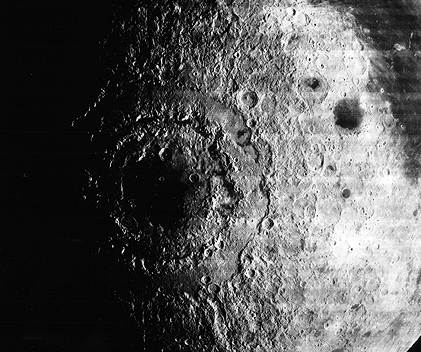Astronomy Picture of the Day
Discover the cosmos! Each day we feature a different image or photograph
of our fascinating universe, along with a brief explanation written by a
professional astronomer.
January 12, 1996

Mare Orientale
Credit:
NASA,
Lunar Orbiter 4
Explanation:
Looking like a target ring bull's-eye, the
Mare Orientale is one of the most
striking large scale lunar features.
Located on the Moon's extreme western edge,
this impact basin is unfortunately difficult to see
from an earthbound perspective.
It is over 3 billion years old,
about 600 miles across and was formed
by the impact of an asteroid sized object.
The collision caused ripples in the
lunar crust resulting in the three concentric
circular features visible in this 1967 photograph made by NASA's
Lunar Orbiter 4. Molten lava from the Moon's interior
flooded the impact site through
the fractured crust creating a
mare.
Dark, smooth regions on the moon are called
mare (Latin for sea),
because early astronomers thought these areas might be oceans.
Tomorrow's picture: Lunokhod 1: Moon Robot
| Archive
| Index
| Glossary
| Education
| About APOD |



Authors & editors:
Robert Nemiroff
(GMU) &
Jerry
Bonnell (USRA).
NASA Technical Rep.:
Sherri
Calvo.
Specific rights apply.
A service of:
LHEA
at
NASA/
GSFC



